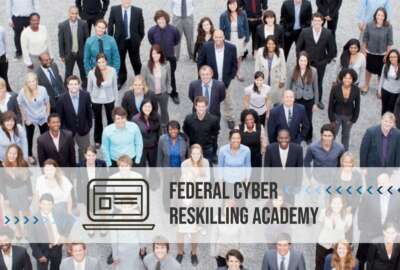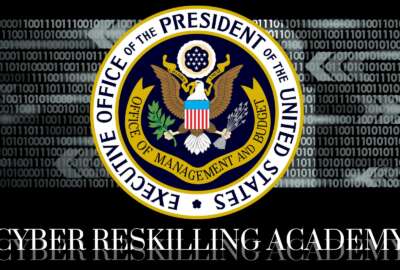
OPM to launch job rotation program for cyber reskilling academy graduates
OPM is working with the Federal CIO Council to create a job rotation program for federal employees who went through the Federal Cybersecurity Reskilling Academy.
The Trump administration has taken steps to reskill the federal workforce for hard-to-fill IT jobs, but the Office of Personnel Management is working to ensure that once employees go through the retraining process, they’ll find a career path they’d like to pursue.
Veronica Villalobos, OPM’s principal deputy associate director for employee services, said the agency is working with the Federal CIO Council to create a job rotation program for federal employees who went through the Federal Cybersecurity Reskilling Academy.
Villalobos said the job rotation for employees would last for nine months, and complement the three months of academy training.
That job rotation would provide an opportunity “where agencies can be exposed to their work and we figure out how they can be a productive fit within the different CIO shops,” she said Tuesday at Nextgov’s IT Modernization Roadmap event. “There’s still hope, and we’re going to figure out how to do this very agilely and be as quick as we can so that those skills don’t grow stale.”
This latest evolution in the administration’s reskilling pilot comes after the first cohort of 30 federal employees — all without IT backgrounds — went through the administration’s first round of reskilling coursework this summer, originally billed as an opportunity to provide them with the skills needed to become cyber defense analysts.
While demand in the reskilling program remains high — more than 1,500 employees applied for the first cohort — some of the employees who went through the academy have gone back to their previous jobs, and remain uncertain about their prospects of moving to a new job in federal IT.
Francisco Salguero, the Agriculture Department’s deputy chief information officer, said that in some cases, a GS-14 federal employee may opt for reskilling coursework in cybersecurity or robotics process automation, only to realize that the training has prepared them for a job series that is a GS-12 or 13 level.
“That’s not conducive to where you want to go, but at least they’ve been exposed to new technology, to a new way to thinking,” Salguero said. “And that’s a big thing — it’s about the mindset and saying, ‘OK, I’m not going to continue doing my work the way I’m doing it today, just because that’s all I know.’ They’re getting exposed to technology and exposed to new ways to do things.”
However, he said that current reskilling efforts are “absolutely” worth it, “because that’s the only way we can start to instill change.”
Meanwhile, the second cohort of the reskilling academy, which graduated last month, included current IT professionals, and the curriculum focused on preparing them to become cyber defense analysts — a goal previously envisioned for the first cohort.
On its website, the CIO Council says it “will evaluate the success of the first two cohorts to determine what additional opportunities may be available in the future.”
Related Stories

Demand pushes CIO Council to increase class size of cyber reskilling academy

Federal Cyber Reskilling Academy to retrain federal employees as cyber defense analysts
“From OPM’s perspective, you can’t really have the technology without the people. People first, really, because if the people don’t adopt it, you’re not going to be able to get as far as you need to with the technology,” she said.
Part of the challenge with reskilling and upskilling efforts, Villalobos said, is that employees remain “fearful” about the process. But OPM, she added, is looking at ways to develop a “continuous growth mindset” for federal employees.
“How do we get employees to expect that their jobs are going to continue to continuously evolve, and that rather than having fear around that, they actually have excitement and opportunity around it?” Villalobos said.
Automation has helped accelerate the need to reskill employees, but it’s also stoked concerns among federal employees that the jobs they’re familiar with might not exist in the near future.
OPM, in its 2018 Federal Workforce Priorities Report, cited a McKinsey study that found workers in 60% of all occupations could see 30% or more of their job functions automated.
“There is excitement for sure,” Salguero said. “There is trepidation as well. There is that fear of the unknown. But if you get just a few folks to be your catalysts and become your evangelists, it actually helps you build it out more into the agency and department.”
But on the flipside, Villalobos said RPA pilots at a handful of agencies, and the process-mapping that comes along with those pilots, has freed employees from having to do the most repetitive and rote functions of their jobs.
“People who were bored in their jobs are now excited to come to work again,” she said.
But aside from reskilling their current workforce, agencies are looking at new ways to retool their recruitment efforts to the right people with the right skills.
OPM recently launched a pilot with the U.S. Digital Service, the Interior Department and the Health and Human Services Department that brings subject matter experts — not just the human resources department — into the hiring process for in-demand talent.
Latest Workforce News
“That particular person, in that particular community of practice — be that design, engineering, product management — they are the experts,” Viza said. “They know what to look for in a resume [and] in an interview. Just because you know all the buzzwords doesn’t make you qualified for a job, and I think that’s been the case for a long time and [we’re] really just trying to transform that.”
As part of that tech talent hunt, Villalobos said OPM has encouraged agency hiring offices to take a more active approach in diversity hiring.
“What we’ve gone back and done with our HR professionals is said, ‘Let’s work together to figure out where we can find diverse candidates,” she said. “And then when we go through any process, even our reskilling processes, we’re being really thoughtful: Are we inviting a wide swath of people from all across our organization to apply to these positions?”
Some agencies, including USDA, have stood out in this effort when it comes to finding a variety of talented personnel to join the Senior Executive Service.
“They knocked on doors and said, ‘Have you thought about applying?’ Because they knew people had skill. It sounds easy, and it really was that easy,” Villalobos said. “When people knew that someone else saw them as having the right skills for an executive position, it got them excited and they applied. Sometimes it’s just knocking on the right door.”
Copyright © 2025 Federal News Network. All rights reserved. This website is not intended for users located within the European Economic Area.
Jory Heckman is a reporter at Federal News Network covering U.S. Postal Service, IRS, big data and technology issues.
Follow @jheckmanWFED






